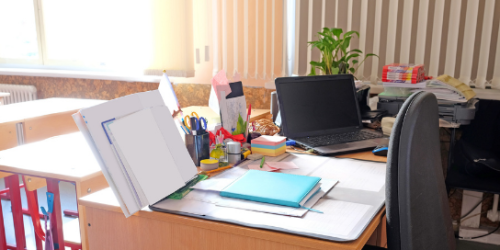
Pay increases and other non-obscure strategies to address the substitute teacher shortage
How several large school districts are revisiting policies surrounding pay and health benefits to attract prospective substitute teachers.

Guest Post by Erin Ruegg and Amanda von Moos, Substantial Classrooms
Keeping the learning going this year has required school and district leaders to solve a moving puzzle each day, often by filling in for teachers themselves. For many, this experience created a new sense of urgency—and responsibility—to better prepare and support substitute teachers.
By the time most students graduate from high school, they will have spent
a whole year of their K-12 experience with substitute teachers. Looking forward, it’s likely that we will rely even more heavily on substitute teachers than we have before, particularly in long-term assignments. And while wages have been increasing to attract more people, substitute teacher preparation and support have remained stagnant and underdeveloped.
Today, if you sign-up to be a substitute teacher in the vast majority of systems, you receive
no training in how to do the job. As highlighted by a recent white paper from EdWeek, only 11% of school districts offer subs professional development (PD) in classroom management, their core job function. Without formal preparation and ongoing support, substitute teachers may struggle to be effective or to find meaning in the work. It’s time to get serious about professional development and support for substitute teachers.
What do subs need to know?
Although there isn’t much formal research about what makes a substitute teacher effective, as an education community, we know a lot about what substitute teachers are asked to do and the qualities that great subs share. At Substantial, we’ve created a simple competency framework for substitute teachers. It synthesizes what we have learned from analyzing sub plans and interviewing hundreds of subs, administrators, teachers, and parents.
Based on our research, there are three main areas where subs need to build their knowledge:
How do you create meaningful PD experiences for subs?
After understanding
what subs need to know, it’s equally important to consider how adults learn and how educators build their practice. Luckily, there is extensive research into effective PD practices for teachers. Mirroring this research, in our experience, effective PD for substitute teachers is active, collaborative, and responsive to their everyday work with students.
Here are a few key strategies:
The pandemic has brought to light the profound impact substitute teaching plays in student learning and school communities. Meaningful PD is critical to improving the quality of teaching and learning, no matter who is leading the instruction. It’s also essential for competing in
today’s labor market—both to attract and to retain substitute teachers.
It’s time to show our substitute teachers that we value them—and the time they spend with our students—by preparing them for the job and actively supporting them throughout their tenure. If we want substitute teachers to show up for our schools, we’ve got to do more to show up for them.
Erin Ruegg leads SubSchool for Substantial Classrooms, which partners with districts to provide ongoing PD for substitute teachers that targets the competencies and strategies outlined above. As a leader in school and curriculum development for over 20 years, Erin works to build the instructional capacity of educators to improve the learning experiences of all students in diverse ethnic, social, and economic settings across the United States and Latin America.
Amanda von Moos is the co-founder of Substantial Classrooms, a national nonprofit on a mission to unlock the potential of substitute teaching, and co-author of the book Substantial Classrooms: Redesigning the Substitute Teaching Experience. A social entrepreneur obsessed with making central office systems work better for schools, Amanda has worked in and with school districts for almost two decades.

How several large school districts are revisiting policies surrounding pay and health benefits to attract prospective substitute teachers.

Are some teacher absences more likely to be covered than others? And what can be learned from the situations when it is not possible to find a sub?

Districts spend on average $18,000 per teacher every year on professional development, with little to show for it. That’s why we were excited to see the new research findings looking at the New Teacher Center’s induction model–most teachers’ first experience with professional development. A recent study found that the New Teacher Center’s approach resulted in up to five months of additional learning. Remarkable!
But there’s a real puzzle here to be solved. While student outcomes–what matters most–showed tremendous gains, teachers’ observation ratings did not. Other than there not being enough observations conducted to detect differences, one explanation may be the instrument used to observe the teachers, that being the tried and true Danielson Framework. It may be time to revisit those indicators to ensure that they align with student outcomes at the earliest stages of a teacher’s career.
Here are the attributes of the NTC approach that yielded dramatic learning gains:
First off, significant time is dedicated to building districts’ capacity to support the induction model. Mentors are carefully selected and intensively trained to assess their teachers, and instructed to meet with each mentee for at least 180 minutes a month and focus on instruction during that time.
Most striking was the program’s significant investment in mentor training–with a requirement of 100 hours of training for each mentor teacher for two years. Could that be the secret sauce?
The big question left isn’t if districts should use this model, but if they can afford it. The cost to implement the program is just $500-$900 per new teacher for the New Teacher Center’s services, but that doesn’t include the districts’ costs for the mentor teachers and any associated stipends or salaries. These line items could run a district $5,600-$8,000 for a fully-released mentor per teacher, depending on the local salary scale (credit to NTC for providing us with these estimates). Our bottom line is that if these outcomes are consistently replicated, the costs are without question fully defensible.